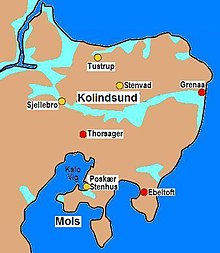Egehøj
The Egehøj ( German "oak hill" ) northwest of Hemmed, east of Bonnerup in Norddjursland , in Jutland is one of the few reconstructed large burial mounds in Denmark . Its reconstruction is based on the excavation from 1969–1972, which showed that the hill went through three construction phases. The reconstruction forms the last construction phase of the hill in the Bronze Age around 1200 BC. From.
Phase 1
The hill, made of plagues of grass, has a diameter of over 15 m and was surrounded by a stone border about one meter high. It contained an oak coffin typical of the Bronze Age, which contained a woman and, as grave goods, a dagger and a bronze needle , as well as two spiral gold rings.
Phase 2
Around 1,000 BC During the second phase of building the mound, the mound was expanded with a one-meter-thick layer of peat and again surrounded with large stones. This hill phase is marked by the interior of the reconstructed stone circle. On the south-eastern side of the hill - outside the original hill border - the approximately four-meter-long stone box that triggered the expansion and contained corpse- fire was discovered.
Otherwise, the burial custom remained the same when changing from the body (which represents the tree coffin burial) to the cremation. In the stone box there were three bronze double buttons , three heart-shaped arrowheads made of flint and leather strips wrapped with brass wire that connected the arrowhead with the arrow shaft and two bronze spirals as grave goods. The stone box burial , which already existed in the Neolithic , is a Bronze Age transitional form between the body burial and the later urn burials .
Phase 3
The hill was covered with a thin layer of earth (around 700 BC) and given a new border (the outer stone circle). Six urn graves exist from this phase. Lumps of amber , a double button and various thin bronze plates were found with the corpse burn.
Egehøj was used as a burial mound for 500 years. It shows how complex the structure of a hill from the Bronze Age can be.
The settlement
To the southeast of the hill, traces of settlement were found on an area of around 20 hectares, 1,225 m² of which were excavated. In one of the pit the traces of three rectangular houses between 18 and 21 m long and about six meters wide could be identified. One of the houses on Egehøj was reconstructed in the Hjerl Hede open-air museum . The house types, the pottery and the flint artifacts dated the houses to the beginning of the Bronze Age around 1700 BC. Chr.
In the 1980s, the settlement at Egehøj was re-examined by extensive excavations. One of the best preserved settlements from the late Neolithic and early Bronze Ages has been uncovered here. The finds from Egehøj are on display in the Djurslands Museum in Grenaa .
literature
- Nils Axel Boas: Bronze Age Houses at Hemmed Church, East Jutland. In: Journal of Danish Archeology, Volume 8, Issue 1, 1989
- Kaare Lund Rasmussen: Radiocarbon Dates from Late Neolithic and Early Bronze Age Settlements at Hemmed, Højgård and Trappendal, Jutland, Denmark. In: Journal of Danish Archeology, Volume 10, Issue 1, 1991
Web links
Coordinates: 56 ° 30 ′ 0.3 ″ N , 10 ° 44 ′ 8.7 ″ E
